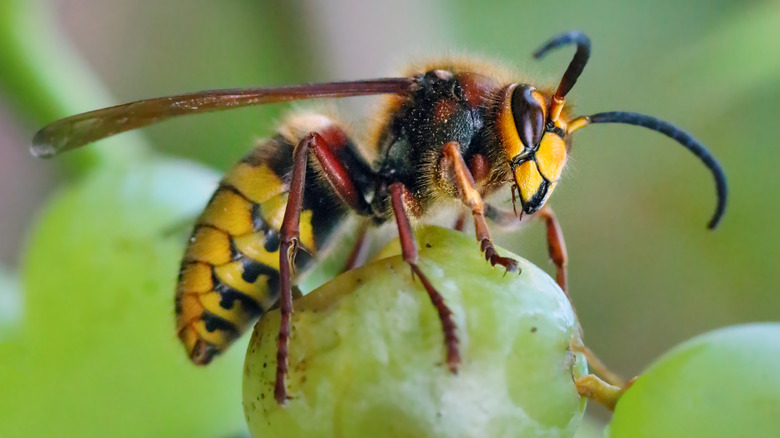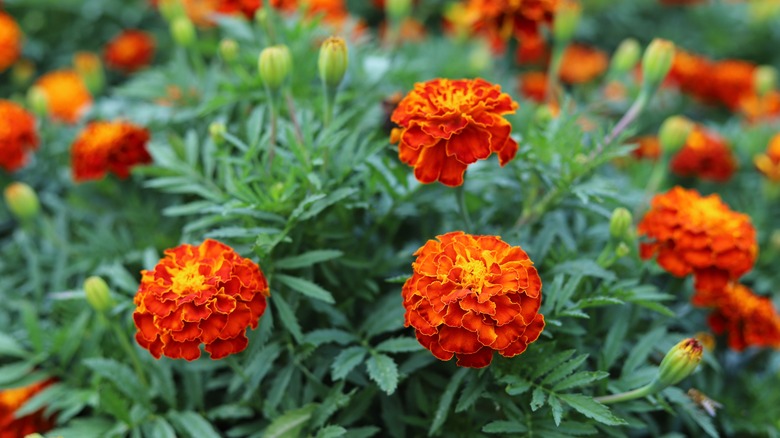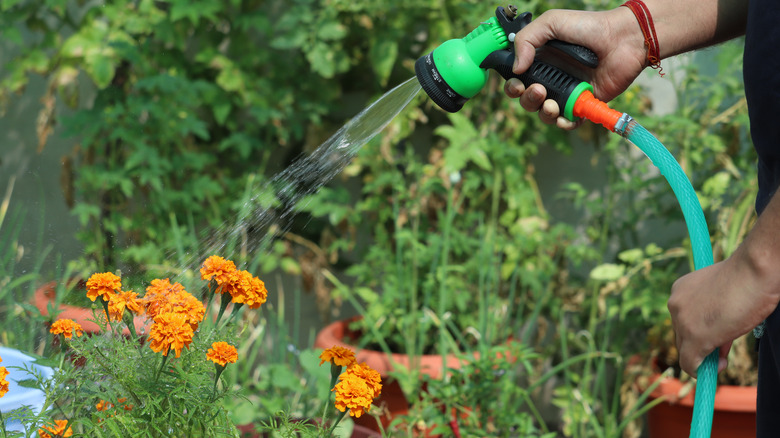The Vibrant Garden Flower That Will Naturally Keep Yellowjackets At Bay
Yellowjackets are one of the many genera of wasps that create a nervous atmosphere in our outdoor spaces, being aggressive with people and harming the nests of the honeybees we all adore. The insects surface in early spring when they lay their eggs, and they only increase in population as fall approaches and they begin to forage for food. Fortunately, there are many plants you include in your garden and around our property to keep wasps away — including marigolds.
While yellowjackets are attracted to sweet aromas, the clustered double-flowers of marigolds produce a pungent smell that will deter these insects and make them think twice before entering the area. The flower — which can be yellow, red, orange, copper, white, brass, gold, or a combination of these colors — is used for things like medicinal purposes and recipes, but it is by far most valued for its ability to deter pests. Easy to grow and care for, marigolds make excellent companion plants and should be on the list of flowers you'll be growing this upcoming season.
How they repel yellowjackets
The marigold flower is known for its prominent smell. It may seem a little musky to humans, but it's overwhelming and acrid to insects like yellowjackets. French and African marigolds actually produce a chemical called thiophene that contributes to their strong scent and can be purchased as an essential oil to distribute around your living spaces. Additionally, some marigolds release a poisonous chemical from their roots that can fight off nematodes, invasive worms that damages plant root systems. The French marigold is generally considered the most effective for this purpose. Marigolds can repel all sorts of other insects too, like mosquitoes, whiteflies, and aphids, not just yellowjackets. They can even help keep deer and rabbits from nibbling away at your garden goods. Generally, marigolds are not favored by any bees either, as their double-flower configuration makes it challenging to collect pollen (and they contain little pollen anyway).
While there is nothing to say that any specific color will drive yellowjackets away, there is evidence that different kinds of colors elicit different responses. Notably, these wasps are attracted to bright shades and less inclined to associate with darker colors like red and black. Though marigold colors might often be appealing to wasps, their smell is enough to deter the insects. For an amplified effect, consider planting them next to other plants known to suppress wasps, such as red geraniums, mint, eucalyptus, and wormwood.
Growing marigolds
Although there are more than 50 species of marigolds, the three most commonly planted around homes include French, African, and Signet marigolds. All varieties love to be grown in full sunlight and tend to do well in hot climates. Signets and African varieties are associated with tolerance to drought, while French marigolds are known to better withstand wetter conditions. Mainly, you'll just want to avoid planting them in shaded and cool locations and aim for a mildly acidic soil pH between 6 and 7 — but never lower than 5.5 — for the best results.
Marigolds can be planted directly into the soil in early spring (after the last frost) and throughout summer. They typically germinate well outdoors, and you don't necessarily need to start these flowers inside before planting them outside. However, African marigolds are the outlier, with this species being a slower grower that benefits from being planted inside at least a month before spring arrives. Many people who choose African marigolds buy them young in nurseries because they take so long to get going. Generally, though, marigold care is straightforward and low maintenance, needing water whenever the soil is dry. You shouldn't fertilize them until they mature so as not to throw off their nutrient balance, and newly planted marigolds will benefit from a layer of mulch to keep the ground moist and fend off weeds.


